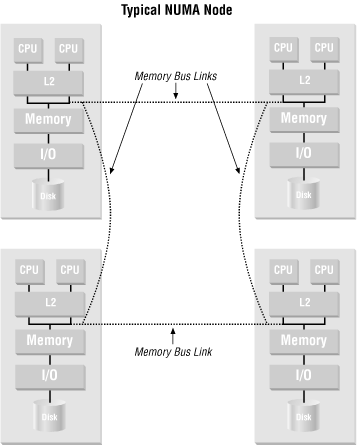Nonuniform Memory Access Systems
Nonuniform Memory Access (NUMA) computers, introduced in the mid-1990s, provide even greater throughput than SMP by linking multiple SMP components via linked distributed memory, as shown in Figure 11-5. Like MPP systems, these systems provide scaling of memory and I/O subsystems in addition to the advantages of using multiple CPUs. However, a single operating system copy manages the platform and a directory-based cache coherency scheme to keep data synchronized. Memory access between nodes is in the hundreds of microseconds, which is much faster than going to disk in MPP or cluster configurations, but slower than local memory access in a single SMP system.

Figure 11-5. Nonuniform Memory Access (NUMA) configuration
NUMA also has a few major advantages over MPP and cluster solutions:
Parallel versions of applications don’t need to be developed to run on these machines (though additional performance gains may be realized when such applications can be tuned for NUMA).
Management is much simpler on NUMA systems than on clusters because there is only one copy of the operating system to manage.
Oracle works with various NUMA vendors to provide highly tunable Oracle versions that can take advantage of the benefits offered by these platforms, such as having data available on local nodes when a query is submitted, which can deliver better performance. Today, ...
Get Oracle Essentials: Oracle9i, Oracle8i and Oracle8, Second Edition now with the O’Reilly learning platform.
O’Reilly members experience books, live events, courses curated by job role, and more from O’Reilly and nearly 200 top publishers.

